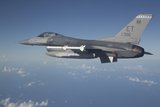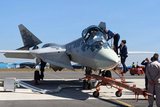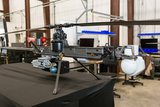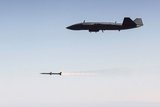Typhoon programme for Kuwait remains on track
The partnership between Italy and Kuwait involves a total of 28 Typhoons, operations, pilot training and support. (Photo: Leonardo)
The fifth and sixth Eurofighter Typhoons for the Kuwait Air Force (KAF) have arrived, Leonardo announced on 29 September.
The delivery of the jets is a part of the Eurofighter Kuwait programme, a comprehensive collaboration between the Italian Air Force and the KAF.
The partnership involves 28 Typhoons, operations, pilot training and support. The Italian Air Force is undertaking initial training, in Italy, for the engineers and technicians who will support the activities of the Typhoon fleet in the country.
‘[The two Typhoons] join the aircraft already in service at the new Salem Al Sabah base which in the meantime have reached the milestone of one hundred air sorties,’ Guido Sibona, VP of Leonardo’s Eurofighter programme, said in a statement.
‘The Eurofighter Typhoons we have developed for the Kuwait Air Force are the most advanced ever produced under the European programme,’ Sibona continued.
The Eurofighter programme is managed by the Eurofighter GmbH consortium, owned by Leonardo, BAE Systems and Airbus Defense & Space for Germany and Spain, with Leonardo representing about 36% of the project.
Related Equipment in Defence Insight
More from Air Warfare
-
![Anduril UK and GKN Aerospace collaborate on British Army ACP bid]()
Anduril UK and GKN Aerospace collaborate on British Army ACP bid
The pair will submit their demonstrator concept for Project Nyx, a development project for the British Army’s Land Autonomous Collaborative Platform.
-
![US Army command’s Picatinny CLIK common lethal drone interface makes progress]()
US Army command’s Picatinny CLIK common lethal drone interface makes progress
The Picatinny Common Lethality Integration Kit is designed to overcome the issue of unique integration methods between lethal payloads and drones as well as avoiding problematic acquisition conditions created by vendor lock.
-
![Australia invests extra A$1.4 billion in MQ-28A Ghost Bat after successful missile fire test]()
Australia invests extra A$1.4 billion in MQ-28A Ghost Bat after successful missile fire test
The investment includes new contracts for six MQ-28A Ghost Bat aircraft, as well as provisional funds to invest in the development of a Block 3 prototype.
-
![Northrop Grumman to fly new Project Talon CCA by late 2026]()
Northrop Grumman to fly new Project Talon CCA by late 2026
The newly unveiled collaborative combat aircraft looks to strike a balance between capability and cost-effectiveness, according to the company.
-
![MBDA and Lockheed move closer to F-35A Meteor flight tests]()
MBDA and Lockheed move closer to F-35A Meteor flight tests
Following the completion of successful ground tests, one more exercise remains before flight testing can begin.
























